Week 5: Creating convincing characters
Use 'Print preview' to check the number of pages and printer settings.
Print functionality varies between browsers.
Printable page generated Friday, 26 April 2024, 5:03 AM
Week 5: Creating convincing characters
Introduction
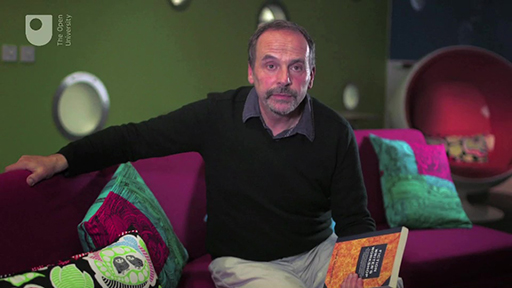
Transcript
You’ve already done some work on character and story, and we’re now going to develop that work with the help of a writer – Josip Novakovich. Like many novelists nowadays he teaches creative writing and he’s also written books on how to write fiction.
Novakovich says this of himself when he started writing: ‘I avoided letting anybody cramp my style. However, I think that I avoided advice and workshops a little too long: some lessons that I learned on my own, I could have learned faster from some good advice.’
This sums up what you stand to gain from studying creative writing.
With the help of Novakovich we will be looking at further ways to find and create characters, and at the importance of conflict in your writing.
5.1 Reading Novakovich
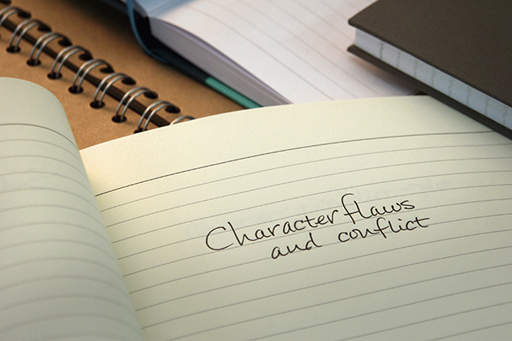
Considering exactly what is meant by character in the context of novels and stories can help you to identify methods for portraying them.
Read the section on character by Josip Novakovich below (the extract is also available as a PDF for your convenience).
As you read, consider these questions:
- What does Novakovich say about character flaws?
- How important is change to characterisation?
- Do all characters need to change in stories?
Take note of the stories and novels that Novakovich mentions. If you get the chance, take a look at some of these for your future research into the ways that writers use and depict character flaws and conflict.
Josip Novakovich – Fiction Writer’s Workshop
Character
Most people read fiction not so much for plot as for company. In a good piece of fiction you can meet someone and get to know her in depth, or you can meet yourself, in disguise, and imaginatively live out and understand your passions. The writer William Sloan thinks it boils down to this: ‘Tell me about me. I want to be more alive. Give me me.’
If character matters so much to the reader, it matters even more to the writer. Once you create convincing characters, everything else should easily follow. F. Scott Fitzgerald said, ‘Character is plot, plot is character.’ But, as fiction writer and teacher Peter LaSalle has noted, out of character, plot easily grows, but out of plot, a character does not necessarily follow. To show what makes a character, you must come to a crucial choice that almost breaks and then makes the character. The make-or-break decision gives you plot. Think of Saul on the way to Damascus: While persecuting Christians, he is blinded by a vision; after that, he changes, becomes St. Paul, the greatest proselyte. Something stays the same, however; he is equally zealous, before and after. No matter what you think of the story of Paul’s conversion, keep it in mind as a paradigm for making a character.
Of course, not all characters undergo a crucial change. With some characters, their unchangeability and constancy makes a story. In ‘Rust’, my story about the sculptor-turned-tombstone-maker, everything (the country, family, town) changes, except the character. Even his body collapses, but his spirit stays bellicose and steadfast. Here he is, at work:
He refused to answer any more of my questions. His hands – with thick cracked skin and purple nails from hammer misses – picked up a hammer. Veins twisted around his stringy tendons so that his tendons looked like the emblem for medicine. He hit the broadened head of the chisel, bluish steel cutting into gray stone, dust flying up in a sneezing cloud. With his gray hair and blue stubbly cheeks he blended into the grain of the stone – a stone with a pair of horned eyebrows. Chiseling into the stone, he wrestled with time, to mark and catch it.
But time evaded him like a canny boxer. Letting him cut into rocks, the bones of the earth, Time would let him exhaust himself.
Seven years later I saw him. His face sunken. His body had grown weaker. Time had chiseled into his face so steadily that you could tell how many years had passed just by looking at the grooves cutting across his forehead. But the stubbornness in his eyes had grown stronger. They were larger, and although ringed with milky-gray cataracts, glaringly fierce.
Whether or not there’s a change in you, character is not the part of you that conforms, but rather, that sticks out. So a caricaturist seeks out oddities in a face; big jaws, slanted foreheads, strong creases. The part of the character that does not conform builds a conflict, and the conflict makes the story. Find something conflicting in a character, some trait sticking out of the plane, creating dimension and complexity. Make the conflict all-consuming, so that your character fights for life. Stanley Elkin, author of The Dick Gibson Show, emphasized the need for struggle this way: ‘I would never write about someone who is not at the end of his rope.’
Think of the basic character conflicts in successful stories. ‘The Necklace’ by Guy de Maupassant: Mme. Loisel, unreconciled to her lower-class standing, strives to appear upper class, at all costs. Out of that internal conflict ensues the tragedy of her working most of her adult life to pay for a fake necklace.
‘The Girls in Their Summer Dresses’ by Irwin Shaw: Though married and in love with his wife, a young man is still attracted to other women.
In Henry James’ ‘The Beast in the Jungle’: John Marcher waits for some extraordinary passion to take hold of him; he dreams of it so much that he does not notice he is in love with May Bertram, who is at his side all along. Only when she dies, of neglect, does he realize it.
In ‘The Blue Hotel’ by Stephen Crane: The Swede, visiting a small town in rural Nebraska, imagines that he is in the wild west and consequently sets himself against a bar of ordinary people whom he imagines as gamblers and murderers.
In all these stories, characters suffer from a conflicting flaw. Aristotle called these character flaws hamartia – usually interpreted as ‘tragic flaw’ (most often hubris or arrogance) when we talk about tragedies. Sometimes, however, a flaw may not lead to disaster, but to a struggle with a subsequent enlightenment. (St. Paul’s zeal, for example, leads him to an epiphany.)
A flaw could result also from an excessive virtue. Look at the opening of Michael Kohlhaas by the early nineteenth-century German writer Heinrich von Kleist:
Michael Kohlhaas ... owned a farm on which he quietly earned a living by his trade; his children were brought up in the fear of God to be industrious and honest; there was not one of his neighbors who had not benefited from his goodness and fair-mindedness – the world would have had every reason to bless his memory, if he had not carried one virtue to excess. But his sense of justice turned him into a robber and a murderer.
Since his horses were abused at a border crossing between two principalities, and he could not get a just compensation in courts, Kohlhaas takes justice into his hands and burns down the castle where the horses suffered. In addition, he burns the city of Dresden, which protected the offenders. His sense of justice provokes a war. His uncompromising virtue may amount to vice – certainly it’s a flaw, the plot-generating flaw.
5.1.1 Character and plot
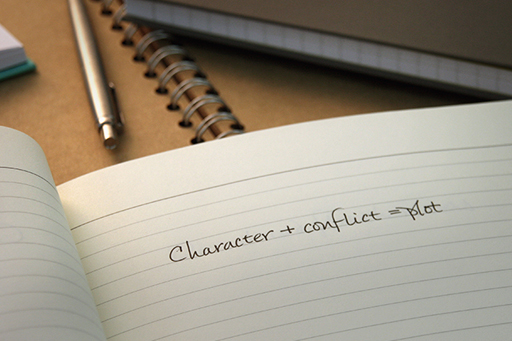
The dictum that ‘character is plot, plot is character’, attributed, by Novakovich, to F. Scott Fitzgerald in the extract that you read in the previous section, is a familiar one, similar to Shakespeare’s ‘Character is destiny’ (from King Lear).
We have already begun to think about how to turn ideas about character into ideas for a plot. Novakovich further develops these thoughts.
This is not to say that what happens to characters is inevitable or predetermined. It’s simply that particular characters seek or attract certain events or encounters.
If you start by building a strong sense of your main character or characters, then add a dilemma, challenge or conflict, you will automatically be generating your plot. Starting the other way around, with a chain of events into which you then fit characters, can often be more difficult and less convincing.
Character + conflict = plot
Apply this formula when building stories. See if it works for you.
5.1.2 Revisit your journal

Look back through characters you have developed in your journal. You may have already thought of flaws and conflicts for your characters.
Find one or more characters now and give these characters a dilemma or a conflict. Does this give more of a story centred on these characters?
Remember that conflicts in this context don’t have to be monumental – they don’t have to be wars, murders, deaths and betrayals (though they might be). They can be relatively domestic matters, but in the context of a particular character’s life they can take on monumental proportions.
5.2 Round and flat characters

Stereotypes can be helpful when we start thinking about creating characters. But developing characters, giving them unexpected contradictions and conflicts, helps to create characters that are living people, not just types or caricatures.
But what about minor characters? How deeply do peripheral characters have to be imagined? Do all characters have to be rounded?
Read Novakovich’s section on ‘Round and flat characters’ below (also available as a PDF for your convenience). The ‘above examples’ in the opening sentence refer to the characters discussed in the previous section on characters that you looked at in Reading Novakovich.
- What does Novakovich say that most round characters possess?
- What are typical features of flat characters?
- Are flat characters okay in some circumstances?
- Are all stereotypes necessarily bad?
Round and flat characters
Most of the characters in the above examples could be called round characters because they have three dimensions, like a ball. These characters are complex, possessing conflicting traits. Mme. Loisel is both frivolous and responsible. The Swede is paranoid yet insightful. John Marcher is sensitive yet callous. In writing, you must not oversimplify –that is, create flat characters. (It’s all right to have flat characters as part of a setting but not as part of an interactive community, the cast of your story.)
Flat characters have few traits, all of them predictable, none creating genuine conflicts. Flat characters often boil down to stereotypes: fat, doughnut-eating cop; forgetful professor; lecherous truck driver; … shifty-eyed thief; anorexic model.
Using these prefab characters can give your prose a semblance of humor and quickness, but your story featuring them will have about as much chance of winning a contest as a prefab apartment in a competition of architects. Even more damaging, you will sound like a bigot. As a writer you ought to aspire toward understanding the varieties of human experiences, and bigotry simply means shutting out and insulting a segment of population (and their experiences) by reducing them to flat types.
But can you have a character without types? What would literature be without gamblers or misers? The answer, I believe, is simple: Draw portraits of misers, but not as misers – as people who happen to be miserly. And if while you draw misers as people you feel that you fail to make characters but do make people, all the better. Ernest Hemingway said, ‘When writing a novel a writer should create living people; people, not characters. A character is a caricature.’ So, give us people (‘Give me me.’). Let the miser in me come to life – and blush – reading your story.
5.2.1 Enriching stereotypes
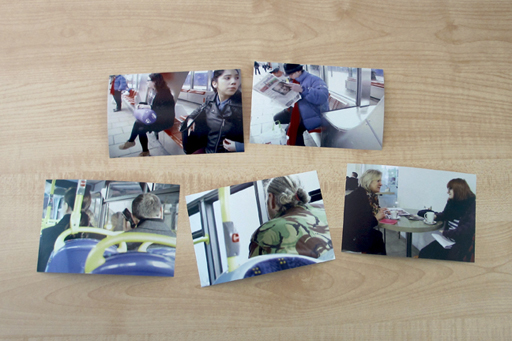
Recalling the real life characters in our video Keeping track of useful details, do any of these suggest a stereotype to you?
If so, can you think of a way in which you might develop such characters beyond stereotype?
Novakovich suggests that showing the contradictions in characters is one way of making them ‘round’. Taking a stereotype and portraying it in a way that goes against the usual expectations is an effective way of making them more complex.
For example:
- the bullying headmaster with a tender sentimental side
- the meticulous manager who lives in a messy house
- the shy librarian who goes bungee-jumping
- the habitual flirt who avoids relationships.
5.2.2 Talking more than types
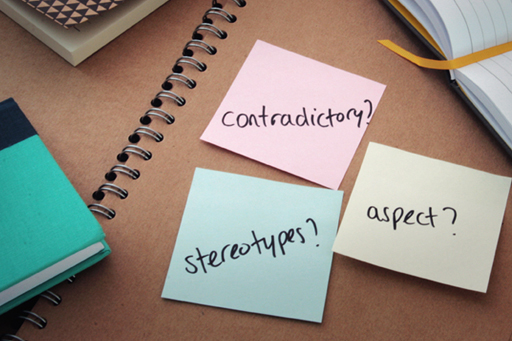
Discussing how stereotypes or flat characters might be made more round can be interesting, not least because it can open your eyes to how stereotypes are commonly perceived and how perceptions can be subtly altered.
Think up some examples of stereotypes that might be made less stereotypical – less flat and more round – by adding an aspect which is contradictory.
5.2.3 Challenging expectations

The challenge now is to write your stereotype in a more complicated fashion. Gauging your characters in terms of stereotypes and considering ways to make them more complex, and offering more nuanced detail about them, will help make your characters more life-like.
Activity 5.1 Creating a complex character
Part 1
Write a brief scene, around 300–500 words, in your notebook, in which you portray a character in a complex way, going against the usual expectations for such a character.
You could:
- take one of the stereotypes mentioned by Novakovich (shifty-eyed thief, forgetful professor, etc.)
- or use one of your own
- or use one of the examples listed in Enriching stereotypes (headmaster, manager, librarian or flirt).
Part 2
Consider the character scene you have just written, and share your thoughts with other writers if you can.
Here are some questions to consider and/or discuss:
- What sorts of stereotypes did you use?
- What sorts of methods did you and other writers use to make the character go against expectations?
- Do you, and other writers, think all of these methods were successful or did some characters remain typical?
- What were the most and least successful methods?
- Which stereotypes were used most commonly as starting points?
5.3 Using yourself
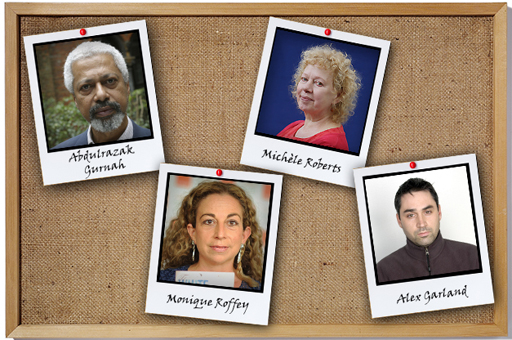
Explore various sources for new fictional characters – where do they come from and how are they developed?
You’ve already done some work on how and where to find and research your characters. Here novelists talk about how they have used themselves in their fiction, often as a starting point for the creation of someone very different.
Transcript
As you’re listening to Abdulrazak Gurnah, Michèle Roberts, Monique Roffey and Alex Garland, make a note of any approaches to finding characters that:
- are similar to your own
- seem quite different but which you might like to try.
5.3.1 Finding and developing fictional characters

The methods of creating characters suggested by Gurnah, Roberts and Roffey may be familiar to you. Novakovich calls this method the ‘autobiographical method’. But, according to him, it isn’t the only method of finding characters.
Read Novakovich’s section ‘Sources of characters’ below. The extract is also available as a PDF for your convenience. Here he outlines methods of finding and developing fictional characters.
- Compare his approaches to the approaches you’ve adopted so far.
- What are his four main methods?
Sources of characters
Where do you find fictional people?
You can completely make them up, using psychology textbooks, astrology charts, mythology, the Bible or, simply, your imagination. This is the ideal method – ideal in a sense that you work from a purely intellectual creation, an idea about a character whom you have not observed and who is not you. Although by using this method you don’t draw from people you know to make your characters, you must speak of real passions, and each character must appear like a real person. Real person is a bit of a contradiction in terms because persona, the Latin root for person, means ‘mask’. We usually take a mask to be the ‘unreal’, phony part of a person. But wearing a mask at a carnival can help you live out your true passions that otherwise, due to social pressures, you keep in check. Fiction is a carnival. So give us real passions with good masks, and everybody will be fair game! Make up character masks, release dramatic conflicts beneath them, and you will create startling people, such as you would like, or fear, to meet.
The mother of all methods – though not necessarily the one you should use most – is the autobiographical method, for it is through your own experience that you grasp what it is to be a person. Because of this, you are bound, at least to some extent, to project yourself into the fictional characters you render by any other method. Many writers project themselves into all the characters they portray. This is, metaphorically speaking, the fission approach: an atom may be split into several, during which an enormous amount of energy is released. Fyodor Dostoyevski split his personality into many fictional ones, all of them as temperamental as he. Mel Brooks, the comedy writer and movie director, thinks this is the primary way to write: ‘Every human being has hundreds of separate people living under his skin. The talent of a writer is his ability to give them their separate names, identities, personalities, and have them relate to other characters living with him.’
In the biographical method, you use people you have observed (or researched) as the starting points for your fictional character. This seems to be the most popular
method. Despite legal limitations on the biographical method, don’t shut down this basic source of fictional characters. Hemingway said that if he explained the process of turning a real-life character into a fictional one, it would be a handbook for libel lawyers. The notion that writers work this way will keep some people quiet around you lest you broadcast their secrets. For a long while it irritated me that my older brother would not believe that I was becoming a writer; and now that he does, it irritates me even more because he does not tell me anything about himself. To find out about him, I talk to our middle brother, and as soon as my older brother finds out that that’s how it works, he probably won’t talk to him either.
Most fictional characters are directly or at least indirectly drawn from life. E.M. Forster, author of A Passage to India, said: ‘We all like to pretend we don’t use real people, but one does actually. I used some of my family ... This puts me among the large body of authors who are not really novelists, and who have to get on as best they can.’ (By the way, most novelists are not really novelists, and they must get on as best they can. Nobody is born with this stuff, and hardly anybody becomes quite secure in the craft. I think that’s comforting: Novelists are regular people, like you and me.)
Using the biographical method, writers often compose their characters from the traits of several people. To express it with another term from nuclear physics, this is the fusion approach: You fuse character traits the way you fuse atoms. Lillian Hellman, author of Pentimento, supports this view of making fictional characters: ‘I don’t think you start with a person. I think you start with parts of many people. Drama has to do with conflict in people, with denials.’ She looks for conflicts in real people and gives these conflicts to her fictional characters, whose traits she gets from other people.
The fourth way to create fictional characters is the mixed method. Writers frequently combine the biographical and the ideal methods since there’s a limit to relying on direct knowledge of characters. In part, this stems from our inability to know people in depth. Somerset Maugham, author of Of Human Bondage, said: ‘People are hard to know. It is a slow business to induce them to tell you the particular thing about themselves that can be of use to you.’ Unless you are a psychiatrist or a priest, you probably will not find out the deep problems of the people around you. That does not mean you can’t use some aspects of the people you know. But soon you must fill in the gaps, and let’s hope that then you will create a character independent from the real-life model. You may use ideas and imagination, or it may happen spontaneously, as it apparently did to Graham Greene, author of The Human Factor, who said: ‘One gets started and then, suddenly, one cannot remember what toothpaste they use ... The moment comes when a character does or says something you hadn’t thought about. At that moment he’s alive and you leave it to him.’ If your character begins to do something different from what the real-life precedent would do, encourage this change, and forget about the real-life model.
Soon you should have someone answering to the necessities of your plot and conflicts, not to the memory of the person you started with.
The ideal to strive for is a character who will come to life seemingly on his own. It will no longer be the person from life outside the novel that served as a starting point, but a fictional one, who not only is there to be written about, but who, in an optimal case, writes for you. Erskine Caldwell expressed this blessed autonomy of fictional characters: ‘I have no influence over them. I’m only an observer, recording. The story is always being told by the characters themselves.’
Not all writers give their characters autonomy and allow them to dictate what to write down. John Cheever said: ‘The legend that characters run away from their authors – taking up drugs, having sex operations, and becoming president – implies that the writer is a fool with no knowledge or mastery of his craft. This is absurd.’ Of course, Cheever believed in his method and distrusted the methods of other authors. I think it’s silly when a writer assumes that his method is the method for all writers. However, it is good to learn what approaches exist, to try them all, and to see which works best for you.
But one principle about constructing characters can be stated unequivocally. Whether your characters attain autonomy or not, whether they come from you or from Greek myths, the more you get to know them, the better you will work with them.
5.3.2 Week 5 quiz
The following quiz will encourage you to think about four ways create to characters.
Complete the Week 5 quiz now.
Open the quiz in a new window or tab then come back here when you’ve finished.
5.3.3 Generating and sharing a character sketch
‘Write what you know’ is a familiar piece of advice often given to writers. But ‘what you know’ can expand through imagination and sympathetic identification with others who are not like you at all.
This is similar to what actors do – they are not confined to ‘playing themselves’ – and neither are writers. But, as Novakovich says, there are other methods for creating your characters besides the autobiographical approach.
Activity 5.2: Trying a new approach to the character sketch
Part 1
Choose one of the methods below, one which is least familiar to you, one you have never tried before:
- Imagine a character very like you but give them a dramatic external alteration. You might make the character the opposite sex, for example, or make them significantly older or younger. You choose.
- Imagine a character very like someone you have observed – but give them a dramatic external alteration. You might make the character the opposite sex, for example, or make them significantly older or younger. You choose.
- Create a character purely on the basis of your imagination or intellectual conception (as described by Novakovich as the ‘ideal method’). Remember, don’t be misled by the term ‘ideal’ – this character won’t necessarily be morally good or well behaved.
- Create a character using any of the above methods in combination, as in what Novakovich calls the ‘mixed method’.
Now write a brief character sketch, around 300–500 words, in which you reveal certain aspects of the character. Use a third-person narrator (‘he’ or ‘she’). Here are some things you might like to include in your sketch but this is not an exclusive list – you may not include all of these aspects; you may include other aspects:
- appearance
- occupation
- voice
- feelings
- current circumstances
- attitudes
- hopes and fears.
Part 2
Share your sketch with some other writers or readers, and ask for their review and feedback.
Remember: if your writing contains graphic material, you should warn your readers.
Part 3
A reader has an intimate relationship with the characters in a story or novel. The reader’s reaction to your character matters.
Read and think about the comments you receive about your character sketch, and ask these questions:
- Has more than one person made the same point about an aspect of the writing?
- Is there anything that people think worked better than you did?
- Is there something you thought worked well that someone else has found less successful?
- Has anyone said something about it that has surprised you?
Reflect on these comments and decide what you agree with and what you are not sure about. Do any of the comments help you to think about how you could change the writing for the better?
Remember: the point of obtaining feedback on your work, and discussing work with fellow writers, is to help you to think about how to improve your writing.
5.4 Summary of Week 5

Character plus conflict equals plot. Novakovich suggests that character must come first and that it is a character’s contradictions and flaws that naturally bring out plot.
This week you will have written a character sketch and may have already received feedback on it from your fellow writers. This process will help you to hone convincing characters who will matter to the reader.
In Week 6, you’ll discover how to develop your characters, look at great examples from other writers and you’ll write the first draft of your final story. You can move on to Week 6 now.
If studying this week of Start writing fiction has inspired you, take a look at the area specifically created for you to explore more about writing fiction on OpenLearn.
References
Acknowledgements
This course was written by Derek Neale.
Except for third party materials and otherwise stated in the acknowledgements section, this content is made available under a Creative Commons Attribution-NonCommercial-ShareAlike 4.0 Licence.
The material acknowledged below is Proprietary and used under licence (not subject to Creative Commons Licence). Grateful acknowledgement is made to the following sources for permission to reproduce material in this unit:
Unit image
Figures
Figure 2 © The Open University/Rory Carnegie (Pears)/Getty Images: Anita Schiffer-Fuchs (Duncker)/J Vespa (Garland)
Figure 8 © The Open University/Getty Images: David Levenson (Gurnah)/Ben Stansall (Roffey)/Jeremy Sutton-Hibbert (Roberts)/J Vespa (Garland)
AV
Research © The Open University/Alex Garland/Tim Pears/Patricia Duncker
Using yourself © The Open University/Abdulrazak Gurnah/Michèle Roberts/Monique Roffey/Alex Garland
Text
Round and flat characters © The Open University / Extract: From Fiction Writer’s Workshop, Copyright © 2008 by Josip Novakovich. Used by permission of F+W Media, Inc. All rights reserved.
Copyright © 2015 The Open University